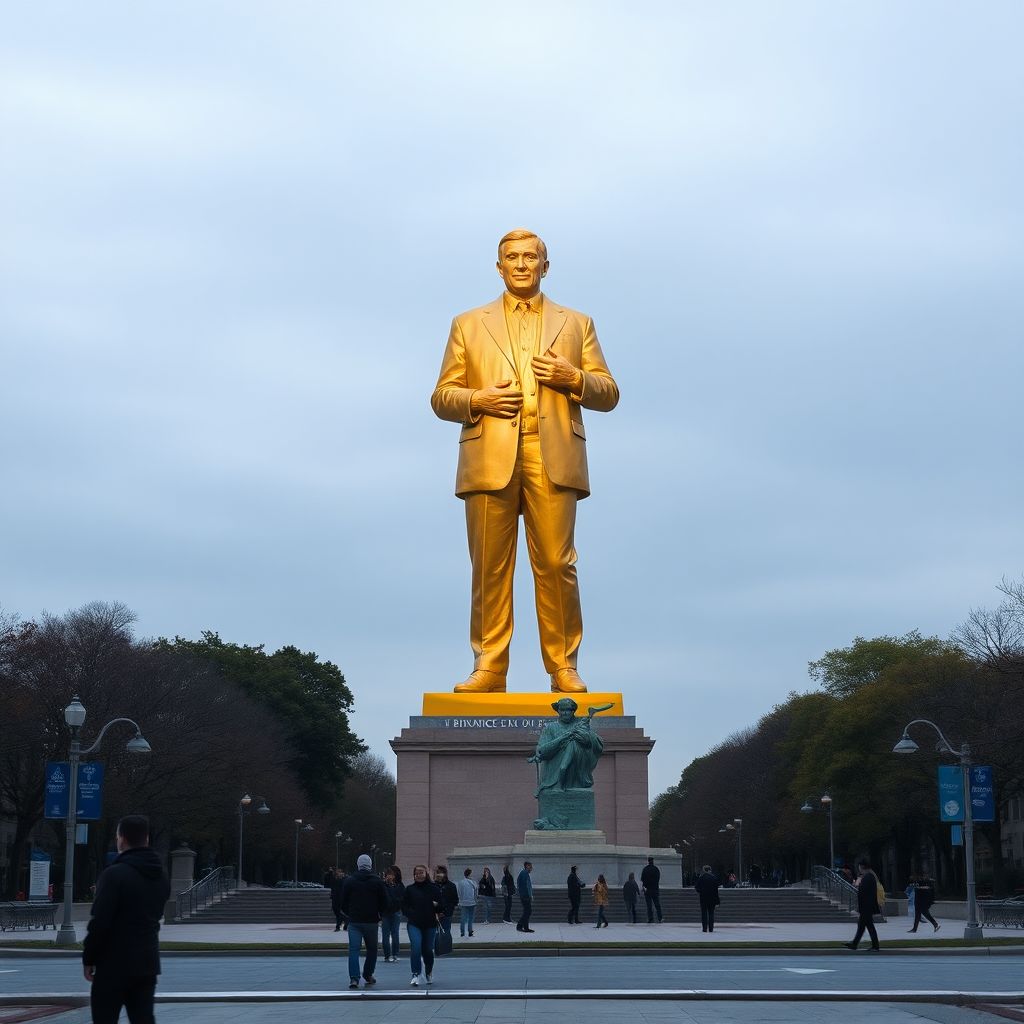A striking new monument is set to join the streets of Washington, D.C.: a 14-foot-tall statue honoring Changpeng “CZ” Zhao, the founder of Binance, one of the world’s largest cryptocurrency exchanges. The tribute comes just days after former President Donald Trump issued a pardon for Zhao, prompting a group of anonymous crypto supporters to commission and fund the statue as a symbol of defiance, innovation, and redemption.
This towering figure, painted in gold, is more than just an artistic installation—it’s a statement. According to an organizer identified as Nick Zee, the statue captures Zhao mid-gesture, holding up four fingers on one hand. This pose references Zhao’s 2023 public rallying cry to the crypto community to ignore “FUD”—fear, uncertainty, and doubt—during a period when Binance and the broader crypto industry faced intense regulatory pressure from U.S. authorities.
The statue’s unveiling is scheduled to take place in Washington, D.C., and it will be on public display for several hours. Afterward, the monument will either be gifted directly to Zhao or sold at auction. Proceeds from the sale, Zee added, will benefit Giggle Academy, a nonprofit educational organization founded by Zhao himself in 2023. The academy focuses on providing free educational resources to underprivileged students around the world, particularly those in developing regions.
Zhao’s journey has been tumultuous in recent years. In 2023, he stepped down as Binance CEO and pleaded guilty to violating U.S. anti-money laundering laws, agreeing to pay a $50 million fine. Binance, under investigation for failing to meet regulatory standards, also paid a multibillion-dollar settlement. Despite these legal challenges, Zhao maintained strong support from the crypto community, many of whom viewed the legal actions as politically motivated or as a misunderstanding of the rapidly evolving blockchain industry.
The unexpected pardon from Trump reignited debate about Zhao’s legacy. For some, it signaled political recognition of crypto’s growing influence; for others, it sparked concerns about the implications of presidential pardons in cases involving global financial systems. Regardless of the controversy, Zhao’s supporters have taken the opportunity to celebrate his contributions to decentralized finance and his role in democratizing access to digital assets.
The statue is not just a personal tribute to Zhao, but also a broader reflection of the tension between traditional institutions and the decentralized ethos of crypto. Its placement in the heart of the U.S. capital is symbolic, drawing attention to the ongoing push-and-pull between innovation and regulation.
Beyond the immediate spectacle, this event marks a turning point in how figures in the crypto world are perceived in mainstream narratives. The erection of statues is typically reserved for national heroes, public servants, or cultural icons. For a tech entrepreneur—especially one recently entangled in legal disputes—to receive such an honor suggests a shift in societal values and the increasing normalization of crypto leadership in public discourse.
The statue’s design is also laced with symbolic elements. Its gold paint nods to both the financial wealth Zhao amassed and the metaphorical “gold rush” of the early crypto era. The four-finger salute recalls not only Zhao’s anti-FUD mantra but also his persistent optimism in the face of legal and reputational challenges.
Critics, however, argue that glorifying a figure recently convicted of financial misconduct sends the wrong message. Some legal experts worry that the spectacle undermines U.S. regulatory agencies’ efforts to foster transparency and accountability in the financial sector. Others see it as yet another example of how wealth and influence can shift public perception, even in the wake of controversy.
The debate over Zhao’s statue is also sparking a wider conversation about the role of public art in shaping narratives around technology and finance. Should innovators in emerging fields be immortalized in the same manner as political leaders or civil rights champions? Or does this set a dangerous precedent, especially when their legacies are still being written?
Regardless of the differing opinions, the statue of CZ has already achieved its goal: to provoke thought, discussion, and engagement. It embodies the disruptive spirit of crypto—a movement that challenges conventional norms and seeks to redefine power structures.
In the coming weeks, crypto enthusiasts and skeptics alike will watch closely to see what becomes of the statue. If it is auctioned successfully, the funds raised could significantly expand Giggle Academy’s reach, enhancing its mission of educational equity. If gifted to Zhao, it may become a lasting symbol of both his achievements and the controversies that followed him.
As the crypto world matures, gestures like this may become more common, reflecting not only the industry’s financial clout but also its cultural and political aspirations. Whether CZ’s statue stands as a beacon of progress or a monument to hubris will ultimately depend on how history judges his contributions—and how the next generation of innovators chooses to build on them.

